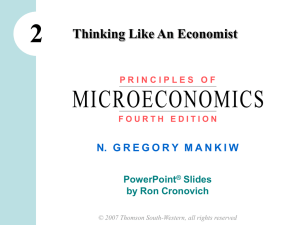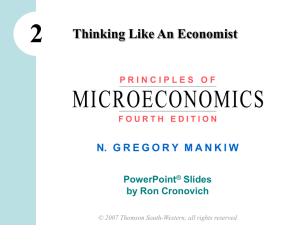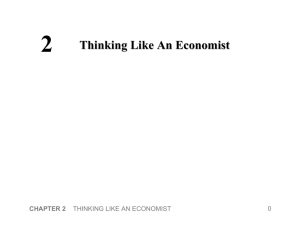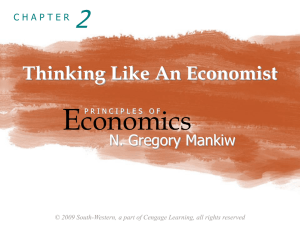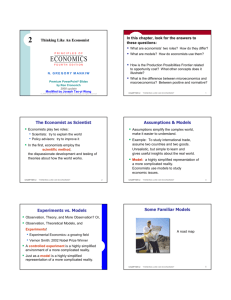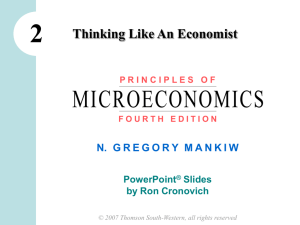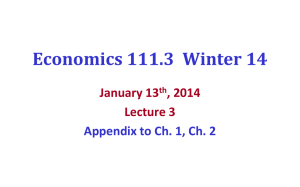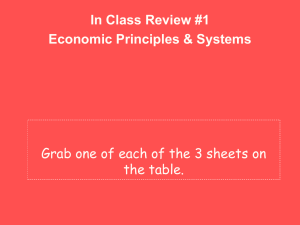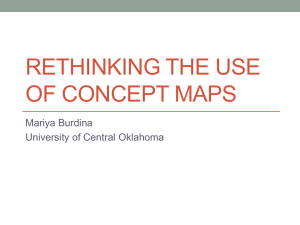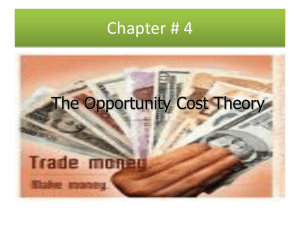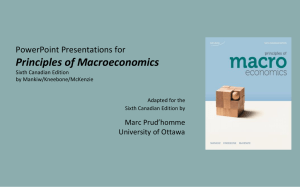Chapter2 - QC Economics
advertisement
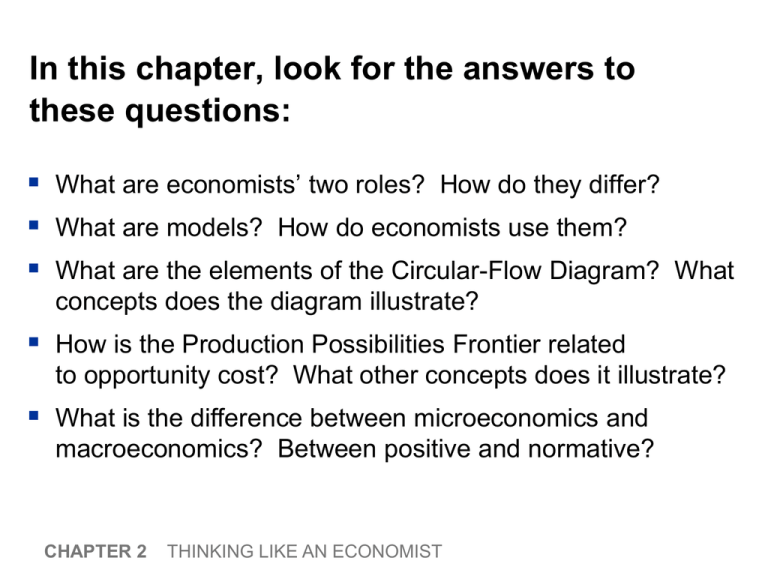
In this chapter, look for the answers to these questions: What are economists’ two roles? How do they differ? What are models? How do economists use them? What are the elements of the Circular-Flow Diagram? What concepts does the diagram illustrate? How is the Production Possibilities Frontier related to opportunity cost? What other concepts does it illustrate? What is the difference between microeconomics and macroeconomics? Between positive and normative? CHAPTER 2 THINKING LIKE AN ECONOMIST The Economist as Scientist Economists play two roles: • Scientists: try to explain the world • Policy advisors: try to improve it In the first, economists employ the scientific method, the dispassionate development and testing of theories about how the world works. CHAPTER 2 THINKING LIKE AN ECONOMIST Presumptions & Models Presumptions simplify the complex world, make it easier to understand. Example: To study international trade, presume two countries and two goods. Unrealistic, but simple to learn and gives useful insights about the real world. Model: a highly simplified representation of a more complicated reality. Economists use models to study economic issues. CHAPTER 2 THINKING LIKE AN ECONOMIST Some Familiar Models CHAPTER 2 THINKING LIKE AN ECONOMIST Our First Model: The Circular-Flow Diagram The Circular-Flow Diagram: A visual model of the economy, shows how dollars flow through markets among households and firms. Two types of “actors”: • households • firms Two markets: • the market for goods and services • the market for “factors of production” CHAPTER 2 THINKING LIKE AN ECONOMIST Factors of Production Factors of production: the resources the economy uses to produce goods & services, including • labor • land • capital (buildings & machines used in production) CHAPTER 2 THINKING LIKE AN ECONOMIST FIGURE 1: The Circular-Flow Diagram Revenue G&S sold Markets for Goods & Services Firms G&S bought Households Factors of production Wages, rent, profit CHAPTER 2 Spending Markets for Factors of Production THINKING LIKE AN ECONOMIST Labor, land, capital Income 6 Our Second Model: The Production Possibilities Frontier The Production Possibilities Frontier (PPF): A graph that shows the combinations of two goods the economy can possibly produce given the available resources and the available technology. Example: • Two goods: computers and wheat • One resource: labor (measured in hours) • Economy has 50,000 labor hours per month available for production. CHAPTER 2 THINKING LIKE AN ECONOMIST PPF Example Producing one computer requires 100 hours labor. Producing one ton of wheat requires 10 hours labor. Employment of labor hours Production Computers Wheat Computers Wheat A 50,000 0 500 0 B 40,000 10,000 400 1,000 C 25,000 25,000 250 2,500 D 10,000 40,000 100 4,000 E 0 50,000 0 5,000 PPF Example Production Point on Comgraph puters Wheat A 500 0 B 400 1,000 C 250 2,500 D 100 4,000 E 0 5,000 Wheat (tons) 6,000 5,000 E D 4,000 3,000 C 2,000 B 1,000 A 0 0 100 200 300 400 500 600 Computers CHAPTER 2 THINKING LIKE AN ECONOMIST Points off the PPF A. On the graph, find the point that represents (100 computers, 3000 tons of wheat), label it F. Would it be possible for the economy to produce this combination of the two goods? Why or why not? B. Next, find the point that represents (300 computers, 3500 tons of wheat), label it G. Would it be possible for the economy to produce this combination of the two goods? 10 Answers Point F: 100 computers, 3000 tons wheat Point F requires 40,000 hours of labor. Possible but not efficient: could get more of either good w/o sacrificing any of the other. Wheat (tons) 6,000 5,000 4,000 3,000 F 2,000 1,000 0 0 100 200 300 400 500 600 Computers 11 Answers Point G: 300 computers, 3500 tons wheat Point G requires 65,000 hours of labor. Not possible because economy only has 50,000 hours. Wheat (tons) 6,000 5,000 4,000 G 3,000 2,000 1,000 0 0 100 200 300 400 500 600 Computers The PPF: What We Know So Far Points on the PPF (like A – E) • possible • efficient: all resources are fully utilized Points under the PPF (like F) • possible • not efficient: some resources underutilized (e.g., workers unemployed, factories idle) Points above the PPF (like G) • not possible CHAPTER 2 THINKING LIKE AN ECONOMIST The PPF and Opportunity Cost Recall: The opportunity cost of an item is what must be given up to obtain that item. Moving along a PPF involves shifting resources (e.g., labor) from the production of one good to the other. Society faces a tradeoff: Getting more of one good requires sacrificing some of the other. The slope of the PPF tells you the opportunity cost of one good in terms of the other. CHAPTER 2 THINKING LIKE AN ECONOMIST The PPF and Opportunity Cost Wheat (tons) 6,000 –1000 slope = = –10 100 5,000 4,000 3,000 2,000 1,000 0 0 100 200 300 400 500 600 Computers CHAPTER 2 THINKING LIKE AN ECONOMIST The slope of a line equals the “rise over the run” – the amount the line rises when you move to the right by one unit. Here, the opportunity cost of a computer is 10 tons of wheat. PPF and Opportunity Cost In which country is the opportunity cost of cloth lower? FRANCE ENGLAND Wine Wine 600 600 500 500 400 400 300 300 200 200 100 100 0 0 0 100 200 300 400 Cloth 0 100 200 300 400 Cloth 16 Answers England, because its PPF is not as steep as France’s. FRANCE ENGLAND Wine Wine 600 600 500 500 400 400 300 300 200 200 100 100 0 0 0 100 200 300 400 Cloth 0 100 200 300 400 Cloth 17 Economic Growth and the PPF With additional resources or an improvement in technology, the economy can produce more computers, more wheat, or any combination in between. Wheat (tons) 6,000 Economic growth shifts the PPF outward. 5,000 4,000 3,000 2,000 1,000 0 0 100 200 300 400 500 600 Computers CHAPTER 2 THINKING LIKE AN ECONOMIST The Shape of the PPF The PPF could be a straight line, or bow-shaped Depends on what happens to opportunity cost as economy shifts resources from one industry to the other. • If opp. cost remains constant, PPF is a straight line. (In the previous example, opp. cost of a computer was always 10 tons of wheat.) • If opp. cost of a good rises as the economy produces more of the good, PPF is bow-shaped. CHAPTER 2 THINKING LIKE AN ECONOMIST As the economy shifts resources from beer to mountain bikes: • PPF becomes steeper • Opportunity cost of mountain bikes increases Beer Why the PPF Might Be Bow-Shaped Mountain Bikes CHAPTER 2 THINKING LIKE AN ECONOMIST At point A, most workers are producing beer, even those that are better suited to building mountain bikes. Beer Why the PPF Might Be Bow-Shaped A So, do not have to give up much beer to get more bikes. CHAPTER 2 THINKING LIKE AN ECONOMIST At A, the opportunity cost of mountain bikes is low. Mountain Bikes At B, most workers are producing bikes. The few left in beer are the best brewers. Beer Why the PPF Might Be Bow-Shaped Producing more bikes would require shifting some of the best brewers away from beer production, would cause a big drop in beer output. CHAPTER 2 THINKING LIKE AN ECONOMIST At B, the opportunity cost of mountain bikes is high. B Mountain Bikes Why the PPF Might Be Bow-Shaped So, PPF is bow-shaped when different workers have different skills, different opportunity costs of producing one good in terms of the other. The PPF would also be bow-shaped when there is some other resource, or mix of resources with varying opportunity costs. • E.g., different types of land suited for different uses CHAPTER 2 THINKING LIKE AN ECONOMIST The PPF: A Summary The PPF shows all combinations of two goods that an economy can possibly produce, given its resources and technology. The PPF illustrates the concepts of tradeoff and opportunity cost, efficiency and inefficiency, unemployment, and economic growth. A bow-shaped PPF illustrates the concept of increasing opportunity cost. CHAPTER 2 THINKING LIKE AN ECONOMIST Microeconomics and Macroeconomics Microeconomics is the study of how households and firms make decisions and how they interact in markets. Macroeconomics is the study of economy-wide phenomena, including inflation, unemployment, and economic growth. These two branches of economics are closely intertwined, yet distinct: they address different questions. CHAPTER 2 THINKING LIKE AN ECONOMIST The Economist as Policy Advisor As scientists, economists make positive statements, which attempt to describe the world as it is. As policy advisors, economists make normative statements, which attempt to prescribe how the world should be. Positive statements can be confirmed or refuted, normative statements cannot. The Government employs many economists for policy advice. E.g., the U.S. President has a Council of Economic Advisors, which the author of this textbook recently chaired. CHAPTER 2 THINKING LIKE AN ECONOMIST Identifying positive vs. normative Which of these statements are “positive” and which are “normative”? How can you tell the difference? a. Prices rise when the government increases the quantity of money. b. The government should print less money. c. A tax cut is needed to stimulate the economy. d. An increase in the price of gasoline will cause an increase in consumer demand for video rentals. Why Economists Disagree Economists often give conflicting policy advice. They sometimes disagree about the validity of alternative positive theories about the world. They may have different values and, therefore, different normative views about what policy should try to accomplish. Yet, there are many propositions about which most economists agree. CHAPTER 2 THINKING LIKE AN ECONOMIST Propositions about Which Most Economists Agree (and % agreeing) A ceiling on rents reduces the quantity and quality of housing available. (93%) Tariffs and import quotas usually reduce general economic welfare. (93%) A large federal budget deficit has an adverse effect on the economy. (83%) A minimum wage increases unemployment among young and unskilled workers. (79%) Effluent taxes and marketable pollution permits represent a better approach to pollution control than imposition of pollution ceilings. (78%) CHAPTER 2 THINKING LIKE AN ECONOMIST FYI: Who Studies Economics? Ronald Reagan, President of the United States Barbara Boxer, U.S. Senator Sandra Day-O’Connor, Supreme Court Justice Anthony Zinni, General, U.S. Marine Corps Kofi Annan, Secretary General, United Nations Meg Witman, Chief Executive Officer, eBay Steve Ballmer, Chief Executive Officer, Microsoft John Elway, NFL Quarterback Tiger Woods, Golfer Ben Stein, Political Speechwriter, Actor, Game Show Host Arnold Schwarzenegger, Governor of California, Actor Mick Jagger, Singer for the Rolling Stones CHAPTER 2 THINKING LIKE AN ECONOMIST CHAPTER SUMMARY As scientists, economists try to explain the world using models with appropriate assumptions. Two simple models are the Circular-Flow Diagram and the Production Possibilities Frontier. Microeconomics studies the behavior of consumers and firms, and their interactions in markets. Macroeconomics studies the economy as a whole. As policy advisers, economists offer advice on how to improve the world. CHAPTER 2 THINKING LIKE AN ECONOMIST
